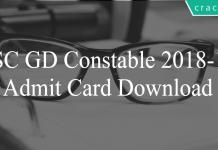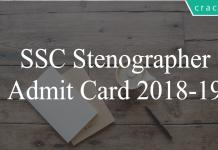Economics Questions For SSC GD PDF Set – 2
SSC GD Constable Economics Question and Answers download PDF based on previous year question paper of SSC GD exam. 40 Very important Economics questions for GD Constable.
ECONOMICS QUESTIONS FOR SSC GD PDF SET – 2
GET 20 SSC GD MOCK FOR JUST RS. 117
Question 1: In a market system, the central problems regarding how much and what to produce are solved through the coordination of economic activities brought about by ________ signals.
a) Supply
b) Demand
c) Price
d) Stock Market
Question 2: The __________ exchange rate is the relative price of foreign goods in terms of domestic goods.
a) Artificial
b) Nominal
c) Fixed
d) Real
Question 3: Which of the following is represented by ‘Lorenz Curve’?
a) Employment
b) Inflation
c) Deflation
d) Income Distribution
Question 4: In which of the following market forms a firm does not exercise control over price?
a) Mixed Competition
b) Monopoly
c) Oligopoly
d) Perfect Competition
Question 5: Which tax causes a burden on the poorer section of the society?
a) Direct Tax
b) Indirect Tax
c) Both Direct and Indirect Tax
d) None of these
Question 6: What does indifference curve represent?
a) Levels of Income and Capital
b) Satisfaction derived from two goods
c) Income from two businesses
d) Relationship between expenditure and savings
Question 7: Which of the following equation is/are INCORRECT? I. NI = NDP + Net Foreign Income
II. GNP = GDP + Net Foreign Income
III. NDP = GNP – Depreciation
a) Only (I) and (II)
b) Only (III)
c) Only (II) and (III)
d) Only (II)
Question 8: Which among the following is not an instrument of fiscal policy?
a) Taxation
b) Public expenditure
c) Public debt
d) Credit Rationing
Question 9: India recently notified the Third protocol to amend Double Taxation Avoidance Agreement with which of the following countries?
a) China
b) Vietnam
c) Singapore
d) Malaysia
Question 10: Which among the following is not a direct tax?
a) Income tax
b) Wealth tax
c) Corporate tax
d) None of these
DOWNLOAD APP TO ACESS DIRECTLY ON MOBILE
Question 11: An economic system combining private and state enterprise is called as _____
a) Market economy
b) Centrally planned economy
c) Private economy
d) Mixed economy
Question 12: Which among the following is an example of micro-economic variable?
a) National Income
b) Aggregate Supply
c) Employment
d) Consumer’s Equilibrium
Question 13: Which one of the following is not an instrument of credit control in India?
a) Rationing of credit
b) Direct Action
c) Open Market operations
d) Variable cost reserve ratios
Question 14: Which among the following is not an account under Balance of Payment?
a) Current Account
b) Capital Account
c) Official Reserves Account
d) Unilateral Payments Account
Question 15: India Paper currency started in?
a) 1860
b) 1861
c) 1862
d) 1863
FREE SSC PRACTICE SET (DAILY TEST)
Question 16: Who has written the book” Capital & Growth”?
a) A.R Rodon
b) Hicks
c) Adam Smith
d) Marshall
Question 17: Who is called the ‘Father of Economics’?
a) Adam Smith
b) Karl Marx
c) Max Muller
d) Winston Churchill
Question 18: Which of the following is a direct tax?
a) Excise duty
b) Sales Tax
c) Income Tax
d) VAT
Question 19: According to the classical system, Saving is a function of?
a) Income
b) Interest rate
c) Real wage
d) Price Level
Question 20: Which term is not related to banking?
a) CRR
b) NEER
c) SLR
d) Fixed Deposit
Question 21: Debenture holder of a company is its?
a) Share holders
b) Creditors
c) Debtors
d) Directors
Question 22: The bank cheques are processed by using?
a) OCR
b) MICR
c) OMR
d) PMR
Question 23: Banks in India were nationalised for the first time in the year?
a) 1950
b) 1960
c) 1969
d) 1979
Question 24: The period of the 11th five-year plan is?
a) 2005 to 2010
b) 2006 to 2011
c) 2007 to 2012
d) 2008 to 2013
Question 25: Which plan emphasized removal of poverty for the first time?
a) 4th
b) 5th
c) 6th
d) 7th
Question 26: The planning commission of India was constituted in which year?
a) 1942
b) 1947
c) 1955
d) 1950
Question 27: Which of the following is apex bank for industrial loans?
a) RBI
b) NABARD
c) ICICI
d) IDBI
Question 28: Insurance sector in India is regulated by?
a) RBI
b) CII
c) IRDA
d) SEBI
Question 29: RBI does not transact the business of which of the following state government?
a) Nagaland
b) Assam
c) J & K
d) Rajasthan
Question 30: Parallel economy emerges due to?
a) Tax Avoidance
b) Tax Evasion
c) Tax Compliance
d) Tax Estimation
Question 31: Indirect taxes by nature are?
a) Degressive
b) Regressive
c) Progressive
d) Proportional
Question 32: A taxation is a tool of?
a) Monetary policy
b) Fiscal policy
c) Price policy
d) Wage policy
Question 33: The term stagflation refers to a situation?
a) Growth has no relation to the change in price
b) Rate of growth and prices both are decreasing
c) Rate of growth is faster than the rate of price increase
d) Rate of growth is slower than the rate of price increase
Question 34: Which of the following group suffer the most during inflation?
a) Debtors
b) Creditors
c) Business class
d) Holders of real assets
Question 35: ‘Neo-Malthusian Theory’ is associated with which of the following?
a) Employment
b) Poverty
c) Resource scarcity
d) Income
Question 36: Which one of the following is a component of Food Security System?
a) Buffer stock
b) Minimum support price
c) Fair price shops
d) Mid day meals
Question 37: Balance of Trade is the difference between
a) Country’s Income and Expense
b) Country’s Exports and Imports
c) Country’s Tax Revenue and Expense
d) Country’s capital inflow and outflow
Question 38: If demand curve for a fishing rod is D = 37000 – 11P and supply curve is S = 12000 + 9P, find the equilibrium quantity?
a) 1250 units
b) 23250 units
c) 52350 units
d) 2500 units
Question 39: Stagflation is defined as
a) low inflation, low growth, low unemployment
b) high inflation, low growth, high unemployment
c) high inflation, high growth, high unemployment
d) low inflation, high growth, low unemployment
Question 40: A beedi making workshop can hire 5 women by paying them Rs. 300 per day. The 6th woman demands Rs. 350 per day. If this woman is hired then all other women must be paid Rs. 350. The marginal resource (labour) cost of the 6th woman is
a) Rs. 600
b) Rs. 50
c) Rs. 300
d) Rs. 100
Answers & Solutions:
1) Answer (C)
2) Answer (D)
3) Answer (D)
4) Answer (D)
5) Answer (B)
6) Answer (B)
7) Answer (B)
8) Answer (D)
9) Answer (C)
10) Answer (D)
11) Answer (D)
12) Answer (D)
13) Answer (D)
14) Answer (C)
15) Answer (B)
16) Answer (B)
17) Answer (A)
18) Answer (C)
19) Answer (A)
20) Answer (B)
21) Answer (B)
22) Answer (B)
23) Answer (C)
24) Answer (C)
25) Answer (A)
26) Answer (D)
27) Answer (D)
28) Answer (C)
29) Answer (C)
30) Answer (B)
31) Answer (B)
32) Answer (B)
33) Answer (D)
34) Answer (B)
35) Answer (C)
36) Answer (A)
37) Answer (B)
38) Answer (B)
39) Answer (B)
40) Answer (A)
DOWNLOAD APP FOR SSC FREE MOCKS
We hope this Economics questions for SSC GD will be highly useful for your preparation.





